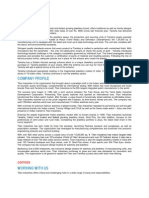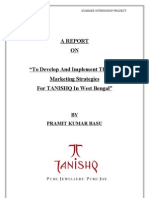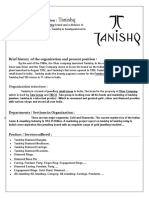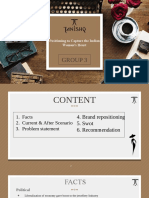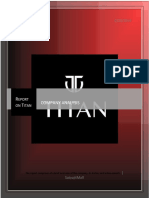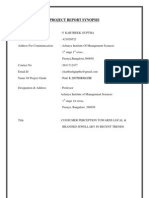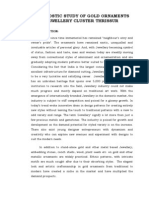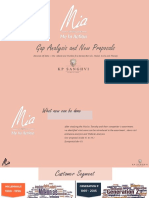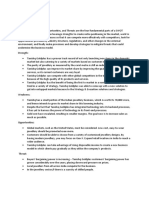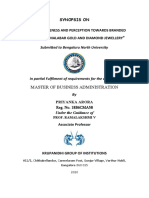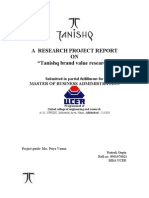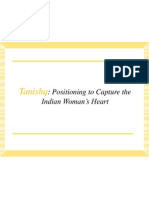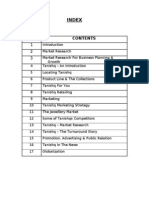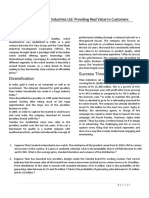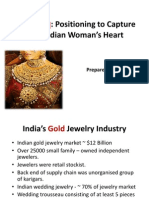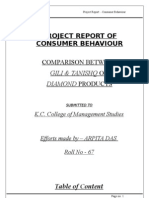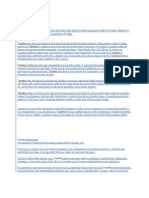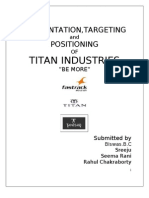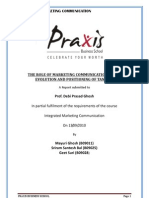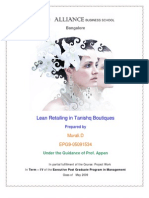IMC - Tanishq
IMC - Tanishq
Uploaded by
sriram_balCopyright:
Available Formats
IMC - Tanishq
IMC - Tanishq
Uploaded by
sriram_balOriginal Title
Copyright
Available Formats
Share this document
Did you find this document useful?
Is this content inappropriate?
Copyright:
Available Formats
IMC - Tanishq
IMC - Tanishq
Uploaded by
sriram_balCopyright:
Available Formats
INTEGRATED MARKETING COMMUNICATION
THE ROLE OF MARKETING COMMUNICATION IN THE
EVOLUTION AND POSITIONING OF TANISHQ
A Report submitted to
Prof. Debi Prasad Ghosh
In partial fulfilment of the requirements of the course
Integrated Marketing Communication
On 13/09/2010
By
Mayuri Ghosh (B09011)
Sriram Santosh Bal (B09025)
Geet Suri (B09028)
PRAXIS BUSINESS SCHOOL Page 1
INTEGRATED MARKETING COMMUNICATION
Tanishq: The Sparkling Journey
ewellery has long graduated from being a three dimensional bank statement. It has now
J
become a personal statement of taste. With that, it has to prove a lot more than its weight in
gold to appeal to the contemporary buyer.
No wonder jewellery has always been a big business in India. Titan came into existence in July
1984, when the Tata Group joined hands with the Tamil Nadu Industrial Development
Corporation (TIDCO) to make a foray into the watch industry.
In June 1995, when Tanishq entered the segment, the market was dominated by the
neighbourhood sonars (goldsmiths) who would craft designs in gold for women. Sometimes
the finesse would be missing; often the gold would not be pure. Tanishq, as the first brand of
jewellery in the Indian market, changed all that. It promised pure gold and offered elegant
designs at transparent prices.
Since then, Tanishq has built on its first mover advantage and remained the market leader
through the years, despite many new entrants to the business. The company has been
growing at the rate of 40 per cent per year for the past five years and has registered a
turnover of over Rs 3056 crores in 2009-10. The target now is to achieve a turnover of Rs
3646 crore in the current fiscal.
The Tanishq saga began in the early 1990’s, primarily fuelled by the fabled Tata
entrepreneurial spirit and partly forced by circumstance.
The splendid Titan watches success story was already up and running, and happened
to need more foreign exchange to purchase the imported components and machines
required to keep up with the burgeoning watch production.
But with India going through a foreign exchange crisis in the late eighties, there was
no help coming in, forcing Titan to search for a business that would earn them the
required foreign currency.
Indian-made jewellery was already a big foreign currency earner and being strongly
supported by the central government, and also happened to be a very good fit with
the watch business as articles of adornment.
The best known brand names in both Europe and America had watches and jewellery
together, offering further proof that the two industries are intrinsically linked.
It was a business with a huge wealth potential and it added a very feminine offering to
Tata’s long line of products that appealed mostly to the opposite gender.
It also called for an organization that inspired trust and had high order design,
manufacturing, marketing and retailing skills, and Tata fit the bill on all accounts.
The name Tanishq, a blend of two words, 'tan' (body) and 'ishq' (love), was coined by Xerxes
Desai, the Vice- Chairman and Managing Director of Titan. To change its image from a watch
manufacturer to a fashion accessories manufacturer, Titan was renamed Titan Industries Ltd.
in 1995. Later they changed the essence of the name “Tanishq” as a combination of Tata
/Tamil Nadu and Nishq (meaning a necklace of gold coins).
PRAXIS BUSINESS SCHOOL Page 2
INTEGRATED MARKETING COMMUNICATION
In 1992, as part of economic liberalization, the government abolished the Gold Control Act of
1962, allowing free import of gold. In 1993, private companies were allowed to enter the
hitherto restricted gold and diamond mining industry. Foreign investors were allowed to hold
up to 50% equity in mining ventures. August 1992, a pilot plant was set up and production
started in two years later. It was launched in 1994 as a range of jewellery and jewellery
watches meant for the European & American markets. But things began to change globally
around this time, and the West entered a protracted period of slow economic growth
followed by recession. Supplying jewellery to the Americans & Europeans suddenly no longer
seemed an attractive proposition.
Tanishq, an entirely new concept in the Indian market, thus had to struggle hard to be
accepted by the customers. Industry watchers were extremely sceptical of Tanishq and
doubts were being cast over its prospects. In 1996, Tanishq launched its first store. It was a
hitherto untried concept. There was no national jeweller that people could buy from, despite
that India is the largest consumer of gold in the world. Clearly, the local satraps had a very
tight stranglehold on their markets and it was difficult for a pan-Indian player to break into.
Being ethical too was a problem.
As a company which was part of the Tata group, known for maintaining high ethical
standards, Tanishq prided itself on delivering customer value through a fair and transparent
business model.
Tanishq changed its strategy and brought in it the value proposition of gold through higher
karatage and also do away with the shop-in-shop formats and have exclusive Tanishq outlets
in 1998. The same year, it entered another segment, the diamond jewellery as these earned
high bottom-lines.
Till 2000, Tanishq could not find its feet in the market and its losses were mounting. In 1998-
99 it showed losses of Rs 10.40 crore (Rs 104 million) though sales turnover was increasing.
May 2000 turned out to be the defining period in the company's history.
Tanishq had quite a few problems on its hands then. Its high decibel media advertising wasn't
working. A stream of adverse media reports had instilled the fear that its shareholders would
pull out anytime. And worse, it had very little time on its hands to show a turnaround.
They made efforts which paid off. A year later, Tanishq had made its first ever profit in the
entire existence of the company. It was a measly sum of around Rs 2 crore (Rs 20 million), yet
it was a beginning. The next year, the company decided to write off some of the financial
baggage it had been carrying. Profits generated dipped as a result but Tanishq was clearly on
a revival. The company changed quite a few of its original strategies along the way.
Tanishq had its first showroom in Chennai in 1996. Today it has over 60 showrooms in 47
cities. Only six of these are owned by the company. The rest are run by franchisees. The
model has helped take away capital costs from the company and pass them on to franchisees
who will invest money to help the company grow. In all, Tanishq managed to limit its fixed
asset investment to Rs 27 crore (Rs 270 million).
PRAXIS BUSINESS SCHOOL Page 3
INTEGRATED MARKETING COMMUNICATION
Post September 11 attack on the World Trade Centre, the volatility in the gold prices led to a
steep decline in the demand for gold. In 2002, the gold demand declined by 19 per cent, from
843 tonnes to 680 tonnes. However, Tanishq was on a roll. It grew its retail sales during 2002-
03 to Rs 332 crore (Rs 3.32 billion) from Rs 239 crore (Rs 2.39 billion).Almost Rs 57 crore (Rs
570 million) came through corporate sales and exports. Corporate and institutional sales had
become an unexpected money-spinner for the jewellers. Today, Tanishq counts companies
like Hindustan Lever Limited, Pfizer, National Panasonic, UB Group, Tata Tea and Tata
Chemicals are among its clients.
The next three years, saw quite a few changes to the way Tanishq operates. Tanishq was
spreading its glitter, and fast.
Revenue in million rupees
Meanwhile, the business environment had also swung in Tanishq's favour.
Changing consumer demographics due to
Rising incomes,
Dual incomes
Exposure to foreign designs
The above brought about a change in the way people looked at jewellery.
If jewellery was once bought as an investment or as part of a daughter's dowry, it was
no longer the case.
Rise in number of working women and
Rise in disposal incomes,
The above made people begin visiting the jewellery shop more often. Weddings still remain
and will remain the time when maximum money is spent on jewellery, but now impulse
buying is becoming increasingly common.
The big reason Tanishq was able to make so much headway is because
It has never shied away from reinventing itself.
It has introduced ethical practices and design innovations to Indian women.
It has also introduced a number of collections that firmly established its reputation as
a frontrunner on the fashion scene.
A deliberate attempt has been made to identify the jewellery with the aspirations and
emotional needs of consumers, rather than with conspicuous consumption.
PRAXIS BUSINESS SCHOOL Page 4
INTEGRATED MARKETING COMMUNICATION
The most important factor spurring Tanishq's success is innovation —
In the business model
In design
In promotions.
Tanishq took up special projects in the 2005 and later in 2007 and 2008 to:
Design jewellery for Bollywood movie Paheli (2005),
awe-inspiring set of crowns specially crafted for the Indian’s leading beauty pageant,
Femina Miss India (2007)
A historical magnum opus Jodha Akbar (2008)
They used the platform to create, showcase and launch a special collection of jewellery.
In 2010, Tanishq plans:
To enter the lucrative regional ornaments segment as a new strategy to cater to the
diverse requirements of brides from different communities around India. The idea is
to maximise the Tanishq brand presence across regional markets in India. At present,
Tanishq offers only standard jewellery in its wedding range.
The demand for diamonds has been rising steadily and even the conventional gold
buyer is now opting for diamond jewellery. As a part of their strategy, they are
focusing on high-value jewellery which is targeted at the affluent buyer who is less
focused on the investment value and is looking more at the ornamental value.
Tanishq is aiming to penetrate the Rs.900 billion Indian jewellery market and increase
its share of the pie from Rs.30 billion with its mantra of innovations and impressing
more and more customers by their unique set of values – purity, design, relevant
choice, excellent services and an exceptional shopping experience.
Tanishq: In minds or in hearts
Tanishq has been projected as an impeachable mark of trust by raising the awareness of the
people about unethical practices in the jewellery business and then measuring the gold purity
by Karatmeter. Tanishq also has been positioned as a branded jewellery of luxury rather than
commodity. It moves jewellery beyond investment to the fashion and adornment sector.
Segmentation
• Niche Marketing - After its inception in 1995 focus on exports, Tanishq's designs had been
conceptualised for the Western markets and were introduced in India without any
alterations. Tanishq positioned itself as an international brand for the Indian elite. The
brand was targeted at a niche market (However they later on started targeting the mass
marketing since 1997).
• Psychographic Segmentation - Tanishq has found that 40% of the Indian women are
working and they targeted this segment with a specific group of products called Collection-G
(a 9-to-5 jewellery for the working women), even their other collections are a fusion of
contemporary in traditional Indian motifs.
PRAXIS BUSINESS SCHOOL Page 5
INTEGRATED MARKETING COMMUNICATION
• Geographical Segmentation - Tanishq realized that, given the diverse nature of Indian
ethnicity, it would have to satisfy the tastes of all regions. So, the designs became more
ethnic. Tanishq also decided to transpose designs by stocking Bengali designs in Delhi,
Keralite designs in Tamil Nadu and typical designs from Tamil Nadu in Mumbai in order to
appeal to a variety of people.
Target Market –
Class Consumer Profile Product Preference Company
Preference
High Inherited Branded designer jewellery Tanishq
income/Professionals/Industrialists or Diamond jewellery
/exceptional ability
Upper Professionals/Business/Career Branded Jewellery Tanishq
Middle oriented/Executives
Middle White collar , educated Unbranded jewellery as Local
well as high quality jewellers
artificial jewellery
Lower Blue collar, skilled Artificial jewellery No company
Middle preference
Lower Semi skilled No need -------
Initial positioning
It exposed the rampant impurity that prevails in the Indian market.
Tanishq introduced innovations like Karat meter, the only non destructive means to check
the purity of gold.
Tanishq has introduced professional retailing in the form of shop-in-shop format in the
disorganised Indian jewellery bazaar, where women can shop with comfort and peace,
without worrying about the purity of the jewellery they are buying and select from the best
jewellery collections
Tanishq is the only jeweller that houses a fully fledged design studio with a team of several
international award winning Indian designers.
What went wrong?
Tanishq, an entirely new concept in the Indian market, thus had to struggle hard to be accepted
by the customers.
Industry watchers were extremely sceptical of Tanishq and doubts were being cast over
its prospects.
PRAXIS BUSINESS SCHOOL Page 6
INTEGRATED MARKETING COMMUNICATION
Tanishq began by offering jewellery in the 18-carat gold range, with designs borrowed
heavily from contemporary European brands. The company justified its decision saying
that it wanted to be 'different' from the traditional Indian offerings.
Initially with a focus on the export market, its designs were predominantly Western, and
the same line of jewellery was sold in India as well. However, when it shifted its focus to
the domestic market, it was unable to sell these designs.
Its high decibel media advertising wasn't working. A customer survey revealed multiple
problems.
Despite its high-blitz ad campaign, many didn't know what Tanishq was about, the
product proposition and retailing.
Others found it too expensive.
Some felt that the product was not for people like them.
A stream of adverse media reports had instilled the fear that its shareholders would pull
out anytime. And worse, it had very little time on its hands to show a turnaround.
Solution:
Therefore the few steps were:
To change the brand positioning from that of an elitist and Westernized offering to a more
mainstream, Indian one.
The 18-carat jewellery range was expanded to include 22 and 24 carat ornaments as well.
Tanishq also made attempts to redefine traditional styles in its designs. Tanishq realized that,
given the diverse nature of Indian ethnicity, it would have to cater to tastes of all regions.
The fifth anniversary celebrations of Tanishq offered discounts to customers and induced them
to come to the store. The ploy worked and customers waited for the store to open.
Ad campaigns now started to list out the products that Tanishq had.
So bracelets, rings, chains, pendants were explicitly mentioned in each ad.
A range starting at Rs 399 was launched. The aim was to bring down the price barrier
significantly.
Collections for the working women and a new set of contemporary designs were
brought into the stores.
A mix of traditional jewellery and contemporary designs were launched. A steady stream of
jewellery collections with a fusion of contemporary and traditional Indian motifs, each with its
distinct target audience has been launched.
Aria, for seven stone diamond jewellery
Hoopla, focused on diamond studded hoops
Collection-G for lower priced gold jewellery with an interesting twist are just a few lines
that have come out of the Tanishq stable in the last three years.
They learned to value regional preferences. Designs were customised depending on the regions
and markets.
Current Positioning
PRAXIS BUSINESS SCHOOL Page 7
INTEGRATED MARKETING COMMUNICATION
Promise of purity and unique experience:
Design and retail innovations have been the hallmark of Tanishq all these years.
First and only jeweller who guarantees the purity of its gold jewellery and certifies the quality
of its diamonds and coloured gems in writing.
Trust:
It has established itself as a highly ethical player in a market that was rated as having the
highest incidence of under karatage. (Bureau of Indian Standards)
They also have gold meters where one can check the purity of gold.
Luxury:
Tanishq also has been positioned as a branded jewellery of luxury rather than commodity. It
moves jewellery beyond investment to the fashion and adornment sector.
Superior Product:
In order to compete with the regional players, Tanishq introduced the concept of “consistency
in delivering promise.”
Tanishq is known for its ability to develop specialized design collections.
It is the only jeweller that houses a full-fledged design studio with a team of several
international award winning Indian designers.
Offer a totally new perspective to jewellery buying especially when it comes to exquisite
oriental jewellery.
PRAXIS BUSINESS SCHOOL Page 8
INTEGRATED MARKETING COMMUNICATION
SWOT Analysis
PRAXIS BUSINESS SCHOOL Page 9
INTEGRATED MARKETING COMMUNICATION
Ansoff Analysis
Product
Present New
Market
Market Penetration Product development
Present Currently Market Share of Tanishq launches Gland
Tanishq is 2.9%.So Tanishq Slam 2010 collection
has a scope for increasing inspired by two distinct
its market share. regional crafts-
Provide EMI by tying up Gujarati rava work &
with banks. Rajasthani meenakari
Find new applications to targeting the modern
current users: Increasing day woman who is
the versatility of the firmly rooted to her
product in terms of usage. Indian values
For example, provision for
using pendant as earrings,
finger rings and vice versa
Market Development Diversification
New Expand geographically:
Opening new outlets in Related: Gold and diamond
new cities and increasing studded buckles in belts and
the number of outlets in footwear.
the existing cities.
PRAXIS BUSINESS SCHOOL Page 10
INTEGRATED MARKETING COMMUNICATION
Tanishq: Its voice
Tanishq’s marketing and promotional strategies have been equally trend-setting as its
designs. It uses a 360 degrees approach in creating brand equity and a persona of purity, style
and exquisiteness. Tanishq’s marketing strategy focuses on making it the most desirable
brand of jewellery in India. Tanishq is rated as one of India's most aspirational brand of
jewellery. The company aims to further strengthen this appeal by evolving many more
opportunities for consumers to interact with the brand.
The company has two key marketing objectives- first, drawing new customers into its
stores located across the country, and second, building long-term relationships with the
existing and rapidly increasing customer base. It uses media advertising, PR, in-store events
and a range of direct marketing tools to achieve these marketing objectives. The Tanishq
store is always centre-stage in these marketing efforts, the sanctum sanctorum, where the
consumer experiences the brand. The communication and promotion budget was spent
towards advertising, while a portion was also earmarked for promotions tailored to match
regional preferences. The budget was split into four parts, comprising national-level spends
(both electronic and print media), regional budgets, direct mail and research. Since 2001,
Tanishq initiated a long-term media plan, aiming to give the brand a round-the-year
presence and enhance awareness.
The following media channels are predominantly used by Tanishq:
T V Advertisement: Tanishq focus on the emotional attachment in the advertisement like
engagement , marriage, and such other occasions.
Print advertisement: In leading news paper and feminine magazines are targeted to do the
advertisement..
Bollywood tie-up: Has done tie up with Paheli and Jodha Akbar where in the movie the
actors were seen wearing Tanishq jewellery through out. For
Jodha Akbar were they launched a
product line named Jodha Akbar.
The journey of Tanishq began in
positioning itself as a premium brand
for the Indian elite with an
international flavour. The customers
were treated with wine and cheese
during their shopping at an
internationally styled store. As the brand did not cater to the traditional jewellery market, its
communication in the electronic media was on the lines of Billy Joel’s description of a woman
which had a more western image.
(http://www.youtube.com/watch?v=NQ7YtorMdOI)
.
Later, Tanishq's created unique designs with the Indian woman
in mind. Aware that a woman plays different roles at work and
at home, and dresses differently for every occasion, Tanishq
PRAXIS BUSINESS SCHOOL Page 11
INTEGRATED MARKETING COMMUNICATION
has created specific collections that have set a new fashion in jewellery. "We are aligning
ourselves by contemporising traditional jewellery and making it relevant for them," says
Venkataraman.
Their campaign 'the emerging Indian woman' gracefully blends the traditional and the
modern.
(Mom’s farewell http://www.youtube.com/watch?v=a_uYyczxIuQ&feature=related) and (Bengali
newly wed driving http://www.youtube.com/watch?v=vbZNNYflbOQ).
Tanishq has opened first-of-its-kind concept stores at Fort Knox Kolkata, South Extension
Delhi, Kormangala Bangalore and Bund Garden Pune. These stores reflect the new retail
identity of Tanishq the 'Revitaliser of Tradition' and combine the grandeur of the past with
the reality of the present without losing its inherent character and appeal.
Thus, Tanishq synergised between their products, store and advertising – communicating
the brand values and unique proposition to the customer.
Until recently, Tanishq was perceived to be a premium brand. The company is now changing
its focus to include mid-segment consumers also. Tanishq appeals to all discerning
consumers of jewellery in India, not merely to the elite. There are an increasing number of
Indian women who seek the values and the benefits that a brand such as Tanishq offers -
trust and reliability, exquisite designs, and an international shopping experience. To them,
Tanishq is a reflection of their own emerging lifestyle, a judicious blend of traditional values
and a modern outlook. Tanishq is a premium brand, but certainly not a narrowly focused
elitist brand. It caters to a wide segment of discerning consumers, and offers a range of
jewellery, which caters across all these consumer segments.
(Moham: http://www.youtube.com/watch?v=TCJChDO8um8 ).
In this context, Tanishq ‘Solo’ (http://www.youtube.com/watch?v=SuVPvkovonk ) follows in the
rich tradition already established by the earlier branded collections of jewellery - Tanishq
‘Aria’ (http://www.youtube.com/watch?v=zhNI2VzTNLU ),Tanishq ‘Diva’, Tanishq ‘Hoopla’,
Tanishq Collection-G, Tanishq Lightweights, Tanishq ‘Bandhan’ - all of which have similar
broad appeal.
The brand relies on below-the-line support, in
addition to media advertising. When ‘Tanishq
Collection-G’ was launched, a collection of 9-to-5
jewellery for the working woman of today, the
marketing team organized presentations to working
women at several corporate offices, even corporate
canteens during the lunch break. Cross promotional
tie-ups with other ‘working women’ spaces such as
music stores, beauty saloons, lifestyle stores and
bookstores were also organized. The company also
reached out to this target group through exclusive
working women's meets, where well known career women spoke about issues relevant to
working women. In addition, ‘Tanishq Collection-G’ ran joint promotions with brands such
as L’Oreal and Wills Lifestyle, which appeal to a similar set of consumers.
PRAXIS BUSINESS SCHOOL Page 12
INTEGRATED MARKETING COMMUNICATION
The peak periods of sales of jewellery are
festival times or the marriage season.
However, there is considerable purchase of
jewellery which happens, and can
potentially happen during the rest of the
year as well for birthdays, anniversaries,
gifting, impulse purchases, etc. Therefore,
in absolute terms, there is no lean period
for jewellery - the jewellery market can
be stimulated throughout the year,
through a host of well-designed
marketing inputs. Tanishq has
successfully stimulated demand for
jewellery throughout the year through
launches of new jewellery collections, a range of exchange
programs and other offers (for
instance, ‘Impure to Pure’ exchange
offer), and a number of in-store
events. As a result of these efforts, Tanishq grew rapidly for
successive years. Successful demand generation through a slew of
marketing measures is, at the core of the rapid, profitable growth,
which Tanishq has witnessed during the past years.
Electronic media campaigns also started to list out the products
that Tanishq had. Bracelets, rings, chains, pendants were explicitly
mentioned in each of their campaign.
(http://www.youtube.com/watch?v=5t2EwziMWq0&feature=related ).
They also launched a complete product line called the
“Conversations” keeping in tune with the raging popularity that
earrings currently enjoy.
(http://www.youtube.com/watch?v=4VX5cGAJMKA&feature=related &
http://www.youtube.com/watch?v=busspp14Nss&feature=related)
Advertising in movies is not something new for Tanishq though. It
has always resorted to the right movie for promoting its products.
It was the ideal vehicle to position Tanishq in the serious jewellery
space as well as bring it closer to the consumer. Indian fashion is
actually led a lot by films. As a medium it influences customers significantly. Whether the
King Khan starrer Rajasthani eternal love story-Paheli or the historical romantic saga of Jodha
Akbar featuring Hrithik and Aishwarya. TVC showcasing
the Jodha Akbar and Paheli collection from Tanishq;
indeed an advertising strategy, which goes much
beyond what the power of the Hrithik-Ash or Shahrukh
- Rani duo alone can dare to achieve! Bhaskar Bhat, MD,
Titan Industries affirms, “It gave Tansihq a platform to
convey its brand image and at the same time we also
launched a ‘Paheli’ collection”. “The movie will be
PRAXIS BUSINESS SCHOOL Page 13
INTEGRATED MARKETING COMMUNICATION
released in overseas film festivals and we want to reach the NRIs and promote it for their
marriages,” explains C. K. Venkataraman, COO-Jewellery,
Titan Industries.
A unique strategy indeed and goes well with Tanishq’s
brand image of commemorating the heritage of the glory
days of India. Yes, that’s palpable from Tanishq’s earlier
ads, which promoted the product as a classic immortalised
design. Agress Alpana Parida, Head – Marketing &
Merchandising, Tanishq, “That helped us to become the
most trustworthy brand but then it became important to
reach out to the masses also.” Surely, this well justifies
Tanishq’s revelations of many TVCs, which showcased
marriages of different cultures, rich masses indeed!
“Tanishq has been always a progressive brand, which has been able to create a trustworthy
brand image among the niche as well as masses,” elaborates Vikram Tyanath,
Team Leader, Lowe. Concerning its latest ad-splashes, Venkataraman has a word to share,
“Tanishq is a brand for the youth also and that’s precisely what we plan to promote through
our ads. At the same time, we won’t compromise with the ‘trust’ image.” He is also open to
tie-up with movies and to create special TVCs. “Such association has always helped us to
sustain our brand image and we needn’t talk about trust anymore. Rather, now our ads will
talk about craftsmanship & designs,” reveals Parida. So whether Jodha Akbar works at the
box-office is a tale for another day, but as far as Tanishq is concerned, it couldn’t have
imagined a more romantic side to history!
(http://www.youtube.com/watch?v=EqzHybzZbpk)
Keeping in mind the objectives of Tanishq for this association, planned and executed the
following integrated marketing plan:
• Special Line of Tanishq jewellery using the look of the film: Tanishq designed a special line
of jewellery taking into consideration the script and background of Paheli. The various pieces
created by Tanishq were worn by all the actors through the entire duration of the movie.
Never before was a jewellery collection of this magnitude made and launched using the
medium of cinema. The jewellery was displayed throughout the film from its first frame to
the last. There were special moments in the film around a particular jewellery item keeping in
mind that the scenes could be used in creating the TVC.
• Joint Promotion (sponsored TVC) of Tanishq and Paheli: A joint TVC was created which
featured key moments from the movie where Tanishq jewellery was worn by Rani Mukherjee
and Shahrukh Khan. The key message in the TVC was to introduce viewers to the new
collection and invite them to Tanishq stores to experience it. This TVC was aired widely across
all mass entertainment channels. Also, campaign extended to outdoor, ground and in-store
promotions, to promote the new collection inspired from Paheli.
• Point of Sales Promotions: Tanishq created special theme décor around the release of the
movie at their various outlets. The shops were decorated using the Paheli theme with film
posters, facades, pneumonic like puppets, bandhanis etc. The special collection was
showcased prominently within the store. Special brochures and design catalogues were
printed with Rani’s pictures adorning the collection. All buyers were given their jewellery in
specially created ‘Paheli’ boxes along with a personally signed letter from Shahrukh Khan,
asking the buyer to experience the grandeur of Rajasthan.
PRAXIS BUSINESS SCHOOL Page 14
INTEGRATED MARKETING COMMUNICATION
• Events and Programs: The association was further strengthened with the director of Paheli,
Amol Palekar, launching the collection at a special press conference in Delhi. The program,
“Making of Paheli” featured Tanishq marketing Head, Ruchira Puri, speaking about the
association. Also, the opening credits of the film acknowledged Tanishq’s contribution.
Tanishq, launched Colors, an eye-catching collection of pure gold jewellery offset with coloured
stones, Kundan and Jadau. Colours is a line of contemporary adaptation of the traditional jewellery
styles in colourful stones, Kundan, Jadua and enamel detailing, impeccably symbolising today's
woman. The distinguishing feature of this range is the creative attempt made to interpret the many-
layered meanings that colours convey to us and translate them into unique designs to convey the
associations and emotions that colours evoke. A woman has her own preferred colours and uses the
meaning that is associated with those colours to her advantage. So she might use pearls to convey
class and sophistication or may use pinks to subtly hint playfulness or fiery reds to connote victory.
The launch was amidst of a musical rendition by Subha Mudgal and a dance recital. Shubha Mudgal's
style of music and her personality epitomise today's woman hence her association with the Colors
collection.
(http://www.youtube.com/watch?v=gzj9bq645Zg) &
(http://www.youtube.com/watch?v=Nd8Jti91GsA)
Tanishq jewellery brand plans to enter the lucrative regional ornaments segment as a new
strategy to cater to the diverse requirements of brides from different communities around
India. Tanishq will come out with specific traditional collections to cater to brides from the
Punjabi, Bihari, Gujarati, Marwari, Telugu, Tamil, Bengali, Kannada and Marathi communities.
(Regional Wedding http://www.youtube.com/watch?v=cRiw_sgO-nE) (Mom convincing for wedding
http://www.youtube.com/watch?v=QfYLu_MhLQQ&feature=related) ( Print release in Femina
http://www.youtube.com/watch?v=BOQn7sWu0wg)
The Retail Showcase
Retail space can showcase product far more brilliantly than advertising ever can. Retail
space is uniquely positioned to surround the customer’s senses with multiple facets of the
brand’s personality. Unlike most advertising, retail space permits an interactive process of
communication about brand. The first three Ss (showcasing, surround effect and speaking
effectively) make the captivating magic of the brand come alive.
A Tanishq store displays eye pleasing product displays, which completely mesh with brand
personality, attractive store windows, the alluring play of color and lights,key product
features are emphasized, often dramatically and
relatively long consumer attention span by an
effective Sales Officer
Catalogs, “take-one” leaflets, online dialogue
counters in the store can further enhance this
process of speaking to the customer about key
brand benefits. Within the retail space, the
customer is captive audience as he listens to
Retail Sales officers and experiences the brand,
Tanishq.s
PRAXIS BUSINESS SCHOOL Page 15
INTEGRATED MARKETING COMMUNICATION
PRAXIS BUSINESS SCHOOL Page 16
You might also like
- TANISHQDocument4 pagesTANISHQKiran Mesa0% (1)
- TANISHQDocument4 pagesTANISHQKiran Mesa0% (1)
- Project On TanishqDocument58 pagesProject On TanishqAdish Jain50% (4)
- Tanishq JewellersDocument24 pagesTanishq JewellersleeladonNo ratings yet
- 5C Analysis On TanishqDocument7 pages5C Analysis On Tanishqavi100% (1)
- Tanishq Brand AnalysisDocument32 pagesTanishq Brand AnalysisPrathama Deokar100% (2)
- 5C Analysis On TanishqDocument7 pages5C Analysis On Tanishqavi100% (1)
- TANISHQDocument3 pagesTANISHQPrabhat Singh100% (1)
- Tanishq IntroDocument6 pagesTanishq Introsarfaraj123No ratings yet
- Tanishq PresentationDocument13 pagesTanishq PresentationPrashant Saxena100% (1)
- Tanishq: Introduction To OrganizationDocument2 pagesTanishq: Introduction To OrganizationSuraj DeshmukhNo ratings yet
- Tanishq - The Turnaround StoryDocument5 pagesTanishq - The Turnaround StoryPrem UttwaniNo ratings yet
- Tanishq Came With Up With Good Stratergies The Tanishq StratergiesDocument18 pagesTanishq Came With Up With Good Stratergies The Tanishq StratergiesGHGFYGJNo ratings yet
- Tanishq Vs GiliDocument21 pagesTanishq Vs Giliblue_devil8132409No ratings yet
- Final Tanishq Marketing StrategyDocument36 pagesFinal Tanishq Marketing StrategyBalwant OjhaNo ratings yet
- TANISHQ - Group 1 Corporate Communication M5th BatchDocument26 pagesTANISHQ - Group 1 Corporate Communication M5th BatchMausam SharmaNo ratings yet
- A Mini Project On TanishqDocument28 pagesA Mini Project On TanishqNisanth KalluriNo ratings yet
- Market Review For Tanishq... : Click To Edit Master Subtitle StyleDocument13 pagesMarket Review For Tanishq... : Click To Edit Master Subtitle StyleRishabh DugarNo ratings yet
- TanishqDocument2 pagesTanishqAnuradha ChaudhariNo ratings yet
- Future Plans of TanishqDocument1 pageFuture Plans of TanishqMisha Garg0% (1)
- Tanishq Case StudyDocument17 pagesTanishq Case StudyasniNo ratings yet
- Tanishq FinalDocument18 pagesTanishq FinalVishal Chamaria100% (1)
- Company Analysis: Eport ON ItanDocument11 pagesCompany Analysis: Eport ON ItanSatyajit MallNo ratings yet
- Tanishq JRM 090729172938 Phpapp01Document25 pagesTanishq JRM 090729172938 Phpapp01Niket VarmaNo ratings yet
- Titan Gold Plus Case StudyDocument5 pagesTitan Gold Plus Case Studyharish100% (1)
- Consumer Perception Towards Local & Branded Jewellary in Recent TrendsDocument4 pagesConsumer Perception Towards Local & Branded Jewellary in Recent TrendsYkartheek Guptha100% (1)
- TANISHQDocument6 pagesTANISHQdheerajsaiNo ratings yet
- Diagnostic Study Report of Gold Ornaments Jewellary Cluster - ThrissurDocument45 pagesDiagnostic Study Report of Gold Ornaments Jewellary Cluster - ThrissurAditya Razdan100% (1)
- Mia by Tanishq - Brand and Indepth Study - RevisedDocument47 pagesMia by Tanishq - Brand and Indepth Study - Revisedmahima100% (1)
- A Study On Brand Recall of Tanishq Jewellery in Surat CityDocument58 pagesA Study On Brand Recall of Tanishq Jewellery in Surat CityShorabh MastanaNo ratings yet
- Great Time To Be A Woman". The Communication Was On AirDocument8 pagesGreat Time To Be A Woman". The Communication Was On AirAkanksha GoyalNo ratings yet
- TanishqDocument8 pagesTanishqGoutham SunderNo ratings yet
- Titan PDFDocument20 pagesTitan PDFSandeep ChowdhuryNo ratings yet
- Positioning To Capture The Indian Women's Heart: Submitted by Meghna Peethambaran K07033Document12 pagesPositioning To Capture The Indian Women's Heart: Submitted by Meghna Peethambaran K07033meghna0% (1)
- A Marketing Project Report On Tanishq - 76955260Document12 pagesA Marketing Project Report On Tanishq - 76955260afra anjum nadafNo ratings yet
- Group 3 - Case Analysis - TitanDocument3 pagesGroup 3 - Case Analysis - TitanRini RafiNo ratings yet
- Titan Industry Immersion Project ReportDocument30 pagesTitan Industry Immersion Project ReportGowthamRaj100% (1)
- Project Report On "Buying Behaviour of Gold With Regards To Tanisq "Document57 pagesProject Report On "Buying Behaviour of Gold With Regards To Tanisq "vivekNo ratings yet
- Case Study On Gitanjali GemsDocument25 pagesCase Study On Gitanjali Gemsvinay1805No ratings yet
- Titan EncircleDocument8 pagesTitan EncircleAntara Debnath100% (1)
- Jewellery MarketDocument13 pagesJewellery MarketPrathish JosephNo ratings yet
- Model SynopsisDocument6 pagesModel SynopsisVishwa NNo ratings yet
- Tanishq Case StudyDocument5 pagesTanishq Case StudyAnkita BhardwajNo ratings yet
- KALYAN JEWELLERS - PPTX ASSIGNMENTDocument17 pagesKALYAN JEWELLERS - PPTX ASSIGNMENTaryansachdeva2122002No ratings yet
- Questionnaire DraftDocument5 pagesQuestionnaire DraftHisham AshrafNo ratings yet
- Tanishq Jwellery Brand ProjectDocument70 pagesTanishq Jwellery Brand ProjectYashi Gupta0% (2)
- Gitanjali Group.Document30 pagesGitanjali Group.Dhananjay Parshuram SawantNo ratings yet
- TITAN Case AnalysisDocument28 pagesTITAN Case AnalysisBrajesh Singh100% (2)
- Tanishq - Retail StrategiesDocument19 pagesTanishq - Retail StrategiesGurleen KaurNo ratings yet
- 123 Vibhuti PunjabiDocument7 pages123 Vibhuti PunjabiVibhuti PunjabiNo ratings yet
- Profile of Jewellery IndustryDocument71 pagesProfile of Jewellery IndustryFebinBaby GodisgoodNo ratings yet
- Positioning of TanishqDocument34 pagesPositioning of TanishqIshan Vyas0% (1)
- Kalyan 360Document22 pagesKalyan 360Vaibhavi GandhiNo ratings yet
- Strategic Choices of Kalyan JewelersDocument9 pagesStrategic Choices of Kalyan JewelersSIMRAN SHOKEENNo ratings yet
- An Analysis of The Gems & Jewellery Industry in IndiaDocument43 pagesAn Analysis of The Gems & Jewellery Industry in IndiaRanjeet Ramaswamy Iyer100% (4)
- Tanishq Case AnalysisDocument9 pagesTanishq Case AnalysisShivani ShajanNo ratings yet
- Tanishq Jwellery Brand ProjectDocument71 pagesTanishq Jwellery Brand ProjectGiri DharanNo ratings yet
- BSF - Rimjhim Varma - 10PGHR43 - Tanishq JewelleryDocument14 pagesBSF - Rimjhim Varma - 10PGHR43 - Tanishq JewelleryRimjhim VarmaNo ratings yet
- 1.0 Introduction To Topic: 1.1 Who Is Customer?Document33 pages1.0 Introduction To Topic: 1.1 Who Is Customer?goswamiphotostatNo ratings yet
- Tanishq Case Study 6th SemDocument6 pagesTanishq Case Study 6th SemYamini MathurNo ratings yet
- CASE STUDY - Titan Industries LTD PDFDocument2 pagesCASE STUDY - Titan Industries LTD PDFSaurabh SethNo ratings yet
- A Case Study On TitanDocument6 pagesA Case Study On TitanBalasaranyasiddhuNo ratings yet
- Tanishq JRM 090729172938 Phpapp01Document25 pagesTanishq JRM 090729172938 Phpapp01Pragya AgrawalNo ratings yet
- TanishqDocument2 pagesTanishqAnuradha ChaudhariNo ratings yet
- Final Tanishq Marketing StrategyDocument36 pagesFinal Tanishq Marketing StrategyBalwant OjhaNo ratings yet
- Project Report of TitanDocument28 pagesProject Report of TitanAchu JamesNo ratings yet
- Tanishq Vs GiliDocument29 pagesTanishq Vs GiliArpita93% (15)
- Tanishq Is IndiaDocument4 pagesTanishq Is Indianishmitashetty3674No ratings yet
- 4.titan Company Tracing The Journey of Analytics AdoptionDocument26 pages4.titan Company Tracing The Journey of Analytics AdoptionSahil PruthiNo ratings yet
- A Comparative Study On The Consumer....Document33 pagesA Comparative Study On The Consumer....pandeyjdeepakNo ratings yet
- Fast TrackDocument45 pagesFast TrackSAUMYA MNo ratings yet
- Industry Profile TanishqDocument2 pagesIndustry Profile TanishqRaghav JakhetiyaNo ratings yet
- Titan STPDocument23 pagesTitan STPrambo_587% (15)
- Consumer Perception Towards Different Jewellery Brands (Gitanjali, Tanishq, D'damas, and Unbranded)Document62 pagesConsumer Perception Towards Different Jewellery Brands (Gitanjali, Tanishq, D'damas, and Unbranded)Akash Baranwal50% (2)
- 1.0 Introduction To Topic: 1.1 Who Is Customer?Document33 pages1.0 Introduction To Topic: 1.1 Who Is Customer?goswamiphotostatNo ratings yet
- IMC - TanishqDocument16 pagesIMC - Tanishqsriram_balNo ratings yet
- Lean Retailing in Tanishq - DM Term 4 ProjecDocument100 pagesLean Retailing in Tanishq - DM Term 4 ProjecAgraj BhartiyaNo ratings yet
- TitanDocument52 pagesTitanImroz MahmudNo ratings yet
- Indian Gems & Jewellery IndustryDocument16 pagesIndian Gems & Jewellery IndustrychthakorNo ratings yet
- Brand Audit of TANISHQ: March 2019Document19 pagesBrand Audit of TANISHQ: March 2019GladValNo ratings yet
- TANISHQDocument40 pagesTANISHQAnushka MannaNo ratings yet
- Tanishq Case AnalysisDocument9 pagesTanishq Case AnalysisShivani ShajanNo ratings yet
- Marketing CommunicationDocument7 pagesMarketing CommunicationAbhiyan AdhikariNo ratings yet
- Positioning of Tanishq Brand OBDocument34 pagesPositioning of Tanishq Brand OBArfa FatimaNo ratings yet
- Presentation 1Document50 pagesPresentation 1aarti240150% (2)
- Khueli Datta Roshni Gupta Ankita Nandy Madhumita Sonali SubhamDocument20 pagesKhueli Datta Roshni Gupta Ankita Nandy Madhumita Sonali SubhamJatin ChaudharyNo ratings yet
- Tanishq - Wikipedia4Document12 pagesTanishq - Wikipedia4Amit VarkhandeNo ratings yet
